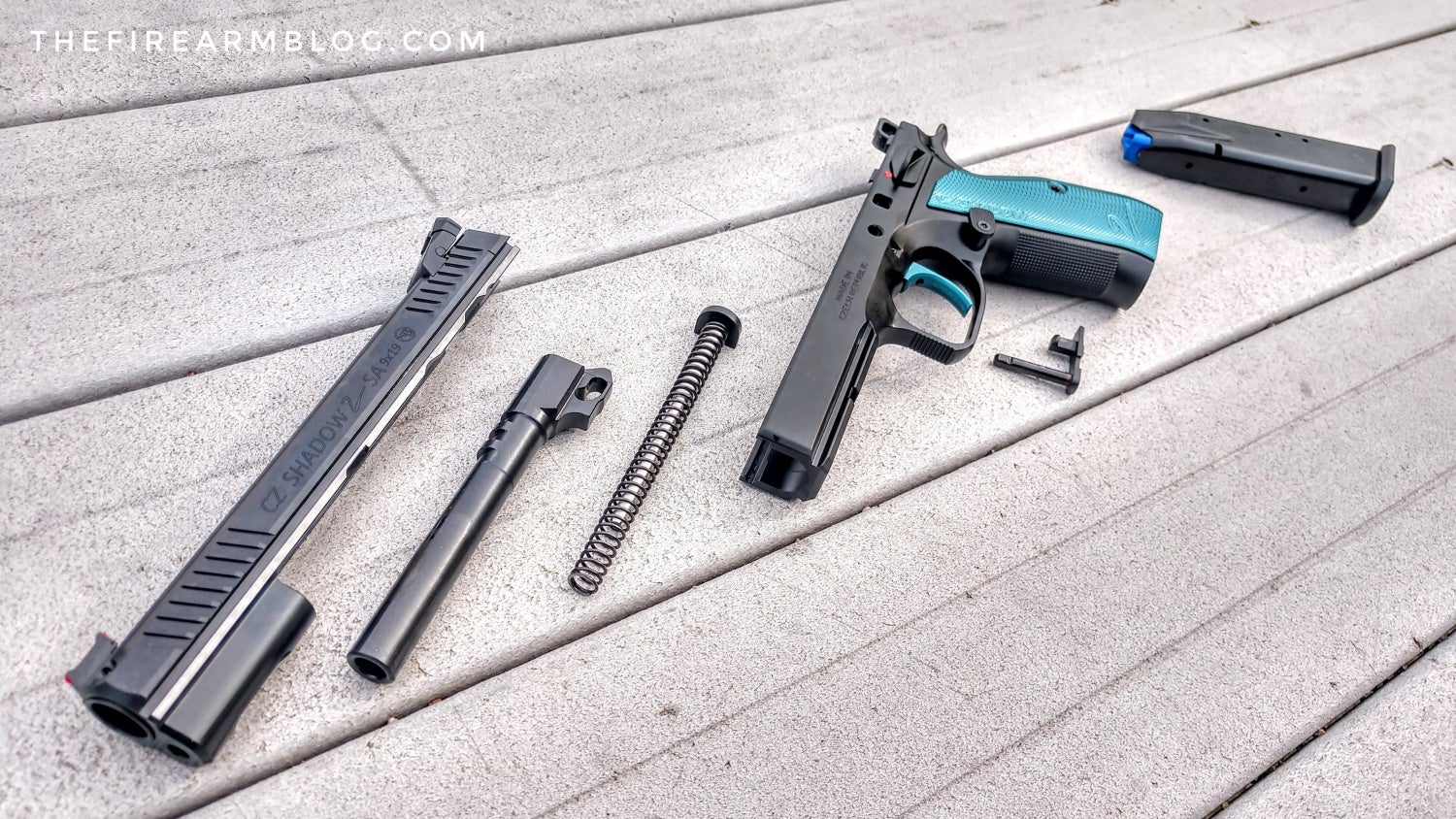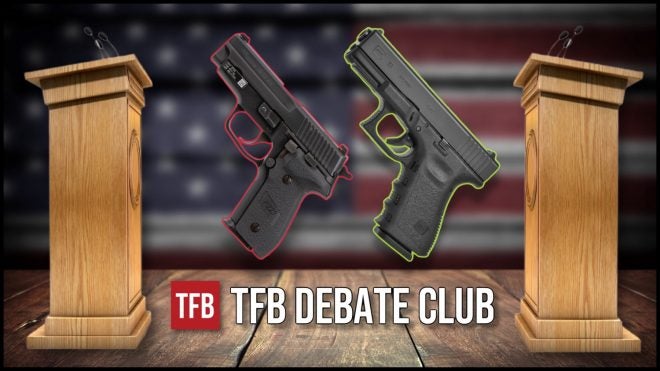Welcome to the TFB Debate Club, where two writers climb into their spider holes and trade volleys on two sides of a hot topic. Last time we met Nick and I sparred off on shooting suppressed versus shooting unsuppressed – I argued against silencer use, a painful dissenting opinion for me. This week Adam and Matt E debate striker-fired pistols and hammer-fired pistols. Is there one correct answer? Let’s find out.
TFB DEBATE CLUB: Striker-Fired Pistols Vs Hammer-Fired Pistols
Pro Striker-Fired Pistols – Adam Scepaniak, TFB, AllOutdoor.com
To hammer, or not to hammer?… That is the question. Seems like there is some innuendo tied in there somewhere, but I promise we are only talking about your firearms (this time). If you peered into my gun safe you might be surprised, but I actually own considerably more guns that are hammer-fired as opposed to striker-fired. To play devil’s advocate against myself, I will offer you 5 reasons why striker-fired is the G.O.A.T. (Greatest of All Time) when it comes to detonating primers and sending lead downrange. Tally-ho ladies and lads! Let’s begin!
Striker-FireD is the G.O.A.T. – #1 Fewer parts
Generally speaking, and with all of the reasons I am about to propose, this is true. When people want to discuss the can-of-worms that is striker-fired versus hammer-fired, the 2 handguns that get pitted against each other are a Glock and a 1911. New against old, plastic versus metal, and a million other comparisons can be drawn. In terms of striker-fired versus hammer-fired, the best argument that can be produced is generally less parts. Glocks advertise as only having 34 parts when stripped into individual parts while a 1911 has 58 or more. Less parts can mean a lot of things: less wearing surfaces, less parts to maintain, less parts that can fail, less moving parts to make the gun function. Regardless of what your emotional ties to a striker versus a hammer might be, you will want the striker because of the inherently more reliable action through less parts.

Striker-Fired is the G.O.A.T. – #2 Lighter weight
Drawing on the issue that was previously mentioned where most striker-fired firearms are polymer/plastic while hammer-fired ones are metal, this brings about the topic of weight. Striker-fired guns, in general, weigh a lot less than their hammer-fired counterparts. You could compare a Smith & Wesson 686 with a 4″ barrel versus a Smith & Wesson M&P M2.0 with the same barrel length. The revolver weighs roughly 40 oz. while the polymer gun weighs 27 oz. – a difference of 3/4 of a pound! If you are carrying a striker-fired versus a hammer-fired all day long for concealed carry, hunting, or even running around during a competition, you are going to feel that weight in a negative way. When you weigh your options, the choice is clear.
Striker-Fired is the G.O.A.T. – #3 no snag, less drag
This concern of snagging hammers on Beretta 92s, CZ 75s, or name “X,Y,Z” revolver on your clothing and discharging a negligent round into a box of orphaned kittens on the sidewalk might sound like a gruesome fairy tale, but it does have some merit. With the striker-fired mechanism fully encapsulated inside the slide of the host gun, it is completely protected from the outside world. That way my clumsy self will not snag the hammer of my revolver on clothing while pumping gas at a gas station and staring in bewilderment at the guy’s jacked-up truck next to me covered in Punisher logo window decals (striker-fired pistols save my life every day and sometimes I don’t even know it). So, keeping the striker-fired mechanism neatly and safely tucked away in the slide is obviously your best path possible.

Striker-Fire is the G.O.A.T. – #4 no debris near ignition
Another reason why you do not want to have your hammer out in the open all willy-nilly like is to avoid having debris or twigs clogging up your pathway to detonation. When you are ready to launch some freedom seeds for some deserving paper targets, a rogue vigilante, or a grizzly that is encroaching on your turf, you do not want to pull the trigger and have it make that deafening “CLICK” sound with the suspicious absence of “BANG.” So, once again it is more reliable, clean, and less death-by-grizzly-mauling-inducing to have a striker-fired gun than it is to have a hammer-fired gun.

Striker-Fire is the G.O.A.T. – #5 all of the above
The final reason why striker-fired is better than hammer-fired is actually a butt load of reasons. What’s that? You don’t think there are a butt load of reasons?… Think again! For one, striker-fired firearms with their less parts require less raw materials, less production hours, and a faster route to scaling. All of which creates a lower cost for us, the end consumers. With less parts also comes a faster learning curve to operating, correctly manipulating all the functions, and mastering the firearm. This includes disassembly, reassembly, and an overall faster learning curve. Also, without the exterior need of percussion from a hammer to ignite rounds, there is a lower bore axis. We can get a purchase and a grip that is higher on the firearm with a striker-fired design that allows for stronger dexterity and an ability to more easily mitigate recoil. Also, striker-fired designs have numerous internal safeties that are not present in hammer-fired weapons. So, from the exterior to the interior, there are simply more safeties. Finally, I always mention looks in every gun I review and this Debate will be no different. Striker-fired guns, typically being of polymer nature, are easier to accessorize, customize, and stipple to your heart’s desire. If you want to customize a hammer-fired gun it is like you are up a creek without a paddle… good luck.
So, from top to bottom as you can see with 5 resounding reasons why striker-fired are better than hammer-fired (plus a butt load of reasons at the end)… I need to now go re-assess every single purchase inside my own safe because I own hammer versus striker at a ratio of 2:1. I hope my good friend and mental combatant this week, Matt E, put up a heck of an argument for hammer-fired guns because I won’t be able to read his rebuttal until this is live like all of you. Cheers everyone!

Pro Hammer-Fired Pistols – Matt E, TFB
The great debate between double-action/single-action and striker-fired guns has been going on since striker-fired pistols first began to appear on the market over 40 years ago. Some of the most iconic firearms in the last 50 years have been DA/SA handguns. Whether it’s the Beretta 92 or SIG Sauer P226, there have been a number of powerhouse handguns that have proven to be built like tanks. Let’s take a look at some of their advantages.

Range Time with DA/SA Pistols
The big difference between DA/SA handguns and striker fired-handguns is the overall trigger feel and how responsive the triggers can be. Often times adding something like an Agency Arms trigger into your Glock will improve the overall pull weight and eliminate the gritty feeling. Even swapping triggers and the trigger bar, a striker-fired system will not typically shoot as well as an upgraded DA/SA gun. Examples like a CZ SP-01 Tactical done up by Cajun Gunworks or even a SIG P226 with an SRT trigger upgrade from SIG can make a nice shooting gun into an extraordinary shooting handgun. If I could pick a well-worked through striker-fired or DA/SA I would 100% choose a DA/SA handgun just for the better triggers and overall solid reliability.

Issues with Striker-Fired Handguns
In the past, there have been a number of handguns that had hydrolocking issues either with their initial spring set up or design. Certain firearms like older style P320s and even the HK VP9 struggle in water with hydrolocking. For those who don’t know, hydrolocking is where water gets into the striker and firing pin area where it slows down the spring creating a light primer strike or not firing because of lack of force from the spring. This may be a simple issue but it’s definitely something to consider when buying a “do all” tough handgun. DA/SA have an advantage since they are hammer-fired and tend to work even when it has water in the firing pin chamber.

Shooting Over Time
Having a quality DA/SA hammer-fired handgun is like having good wine. They get better with time and start to wear in making them incredibly smooth. Having a metal-framed hammer-fired handgun is one of the smoothest shooting handguns that physically feels different. Another great aspect of hammer-fired guns is the ability to shoot single action with the hammer back. Having the ability to shoot in single-action in the range is a great way for new shooters to feel comfortable with a lighter trigger pull with a short reset. Using something like a hammer-fired gun to practice trigger reset is much easier than something with a striker-fired handgun where the trigger reset is typically longer.

Difference In Quality
Another big difference is the overall quality between a polymer striker-fired handgun and a metal-framed hammer gun. Typically with striker-fired guns, they are extremely functional but lacking form or beauty. Other guns like the 1911 are some of the best looking guns but aren’t functionally the best and tend to be finicky. Hammer fired DA/SA handguns are typically the best of both worlds where they can be extremely good looking handguns that remain very reliable.

The overall quality of metal-framed handguns is typically better than those made out of polymer. Metal framed guns will often have tighter tolerances. This ultimately feels like a better build handgun than something like a Glock that’s functionally indestructible but fairly terrible looking with loose tolerances. Having a handgun with higher quality will come at a higher price. This is exactly why the P-series from SIG and CZ 75 line of handguns cost more than something like a simpler Glock or M&P.

Overall Thoughts
Striker fired handguns definitely have their place in the market. They offer great reliability and value for money for what they are. Personally, though, I think having a hammer-fired DA/SA handgun is by far the best option to go with for long term shooting and carrying. For me, having something like a hammer-fired metal-framed handgun is one of the most rewarding guns to learn on. It becomes extremely smooth the more you shoot them and will eventually feel like a handcrafted masterpiece. I have a number of hammer-fired handguns and every time the quality difference between them and striker-fired handguns is apparently. Call me a boomer if you’d like, but they are some of the best handguns on the market in my humble opinion.

Let me know what you prefer in the comments below. Is a striker-fired handgun better for daily life or do the hammer-fired handguns win your heart over? I know there will be arguments for both and would love to hear each side so don’t be afraid to jump in and say your opinion. If you have questions don’t hesitate to reach out to Adam on Instagram @strength_in_arms or myself @fridgeoperator. Stay safe out there.
 Your Privacy Choices
Your Privacy Choices
